Researchers identify mechanism plant cells use to receive messages from neighbors

In the age of tablet computers and smart phones, it's easy to feel inundated and overloaded by information. But on a cellular level, this bombardment is business as usual, and a team of University of Washington researchers has identified a mechanism that some plant cells use to receive complex and contradictory messages from their neighbors.
As they report in a paper published online June 17 in Nature, the team led by UW biology professor and senior author Keiko Torii made its discovery as they explored how plants organize cellular structures on their surface.
Like other multicellular creatures, plants must coordinate activity among many different types of cells and tissues. Messages, demands, warnings and alerts shuttle among cells near and far. These messages determine what jobs cells take on and how they work together to build and maintain tissues and organs. As plants grow, they also use this information to decide where new structures like leaves or roots should go.
Torii, lead author Jin Suk Lee and their colleagues focused on how plants decide where to place stomata: tiny, two-cell openings on the surface that connect the plant's interior with the outside world. Critical for water and gas exchange, stomata develop on the plant's surface based largely on signals they receive from neighboring cells.
"Stomata are so important for plant productivity," said Torii, who is also an investigator with Howard Hughes Medical Institute and the Gordon and Betty Moore Foundation. "They're small but have a big impact."
Plants must grow and distribute their stomata evenly on the surface because too many or too few can disrupt water balance or photosynthesis.

Lee and Torii studied two signals that plant cells release to control where stomata go. These signals are actually proteins, or small molecules that help cells do work and communicate with one another. One is called Stomagen, which promotes stomata development. The other protein messenger—known by its acronym EPF2—opposes Stomagen by preventing stomata formation.
"My lab had previously identified many key factors that control stomata development and enforce proper stomata patterning," said Torii. "We had described EPF2 and another group identified Stomagen. But we did not know how plant cells balanced these two signals."
Her team wanted to understand how cells near the plant's surface recognize Stomagen and EPF2 and how they decide which signal to obey. They studied these questions in a small mustard weed called Arabidopsis thaliana, which researchers including Torii have long studied to understand how plant cells organize themselves into a functional body.
The researchers studied how messages from Stomagen and EPF2 are transmitted in mutant Arabidopsis plants that lacked certain cell surface proteins. Like a person standing in the doorway of a house, these surface proteins have one foot planted outside and the other inside and are important conduits for conveying information and messages into the cell.
They discovered that Stomagen and EPF2 actually compete for access to the same surface proteins that can transmit either a stomata-promoting or stomata-repressing message into the cell based on which signal molecule binds to them. If Stomagen attaches, then the cell receives a message to create a stomata. If EPF2 attaches instead, the surface proteins tell the cell to shut down stomata development.

"The cell has these competing signals that it has to interpret, and it uses the same surface protein for both," said Torii. This type of signal delivery system—where two opposing messages compete directly for access to the same proteins—exists in animals. But this type of antagonistic signaling has never been seen in plants, she added.
This is a particularly surprising finding because Stomagen and EPF2 look very similar to one another. They differ in only a few key qualities. Yet those small differences amount to big differences in the messages they deliver to cells.
The discovery sheds light on the mechanisms that cells employ to detect and process messages—including conflicting signals—from the outside world. In the future, Torii would like to understand how the pro-stomata and anti-stomata messages act once they're inside plant cells.
"This paper is just the beginning," she said.
More information: "Competitive binding of antagonistic peptides fine-tunes stomatal patterning." Nature (2015) DOI: 10.1038/nature14561
Journal information: Nature
Provided by University of Washington


















